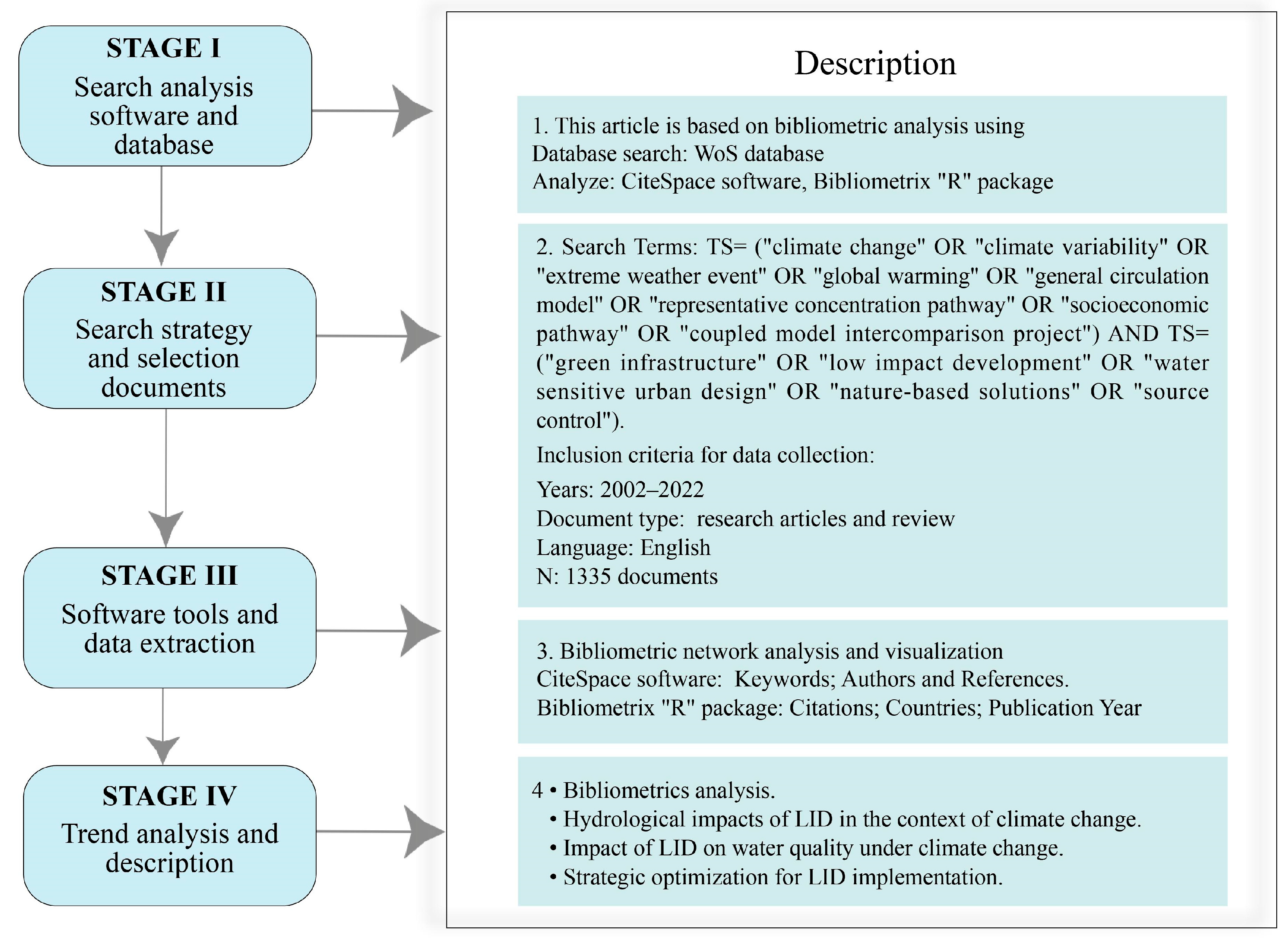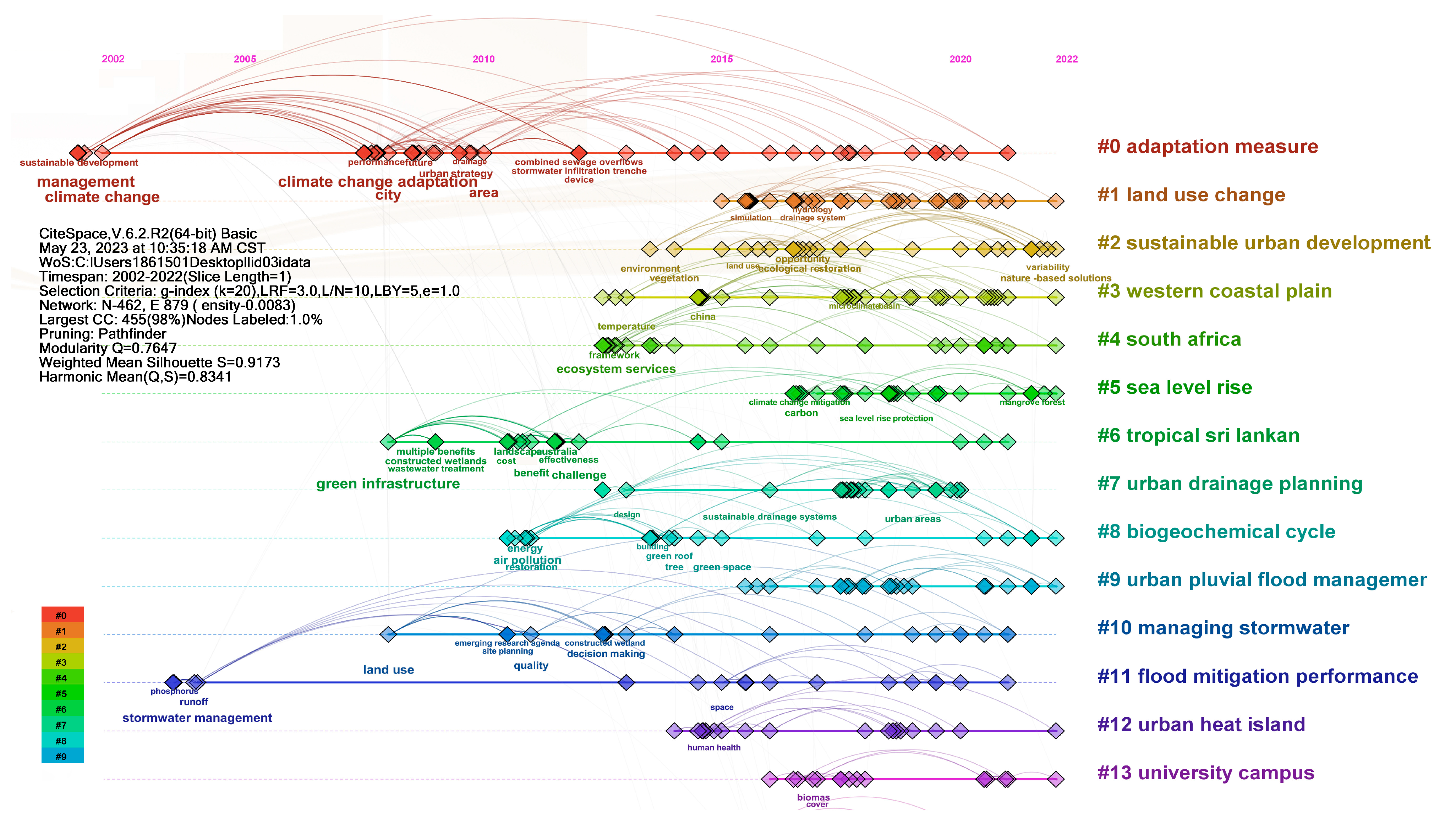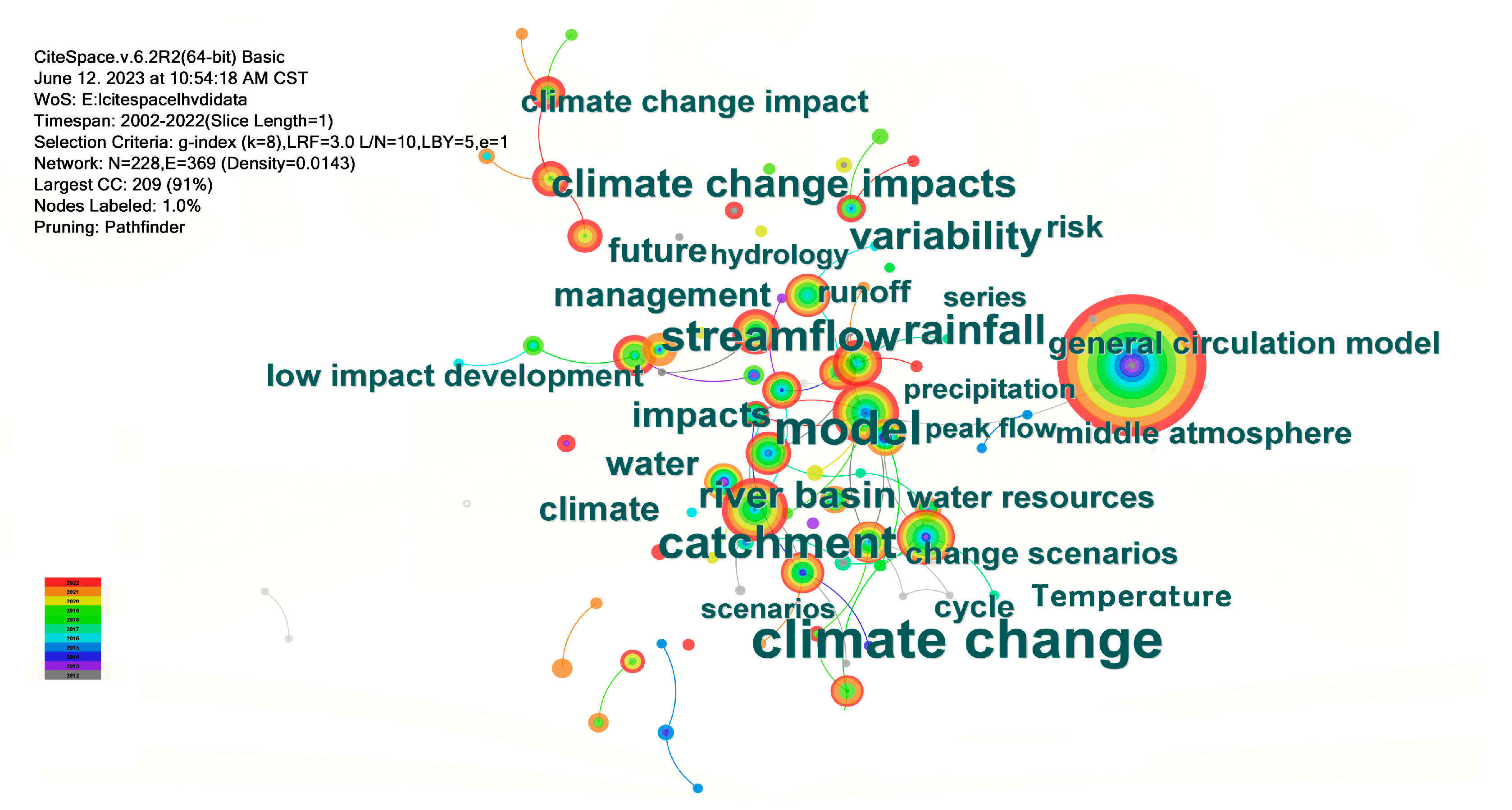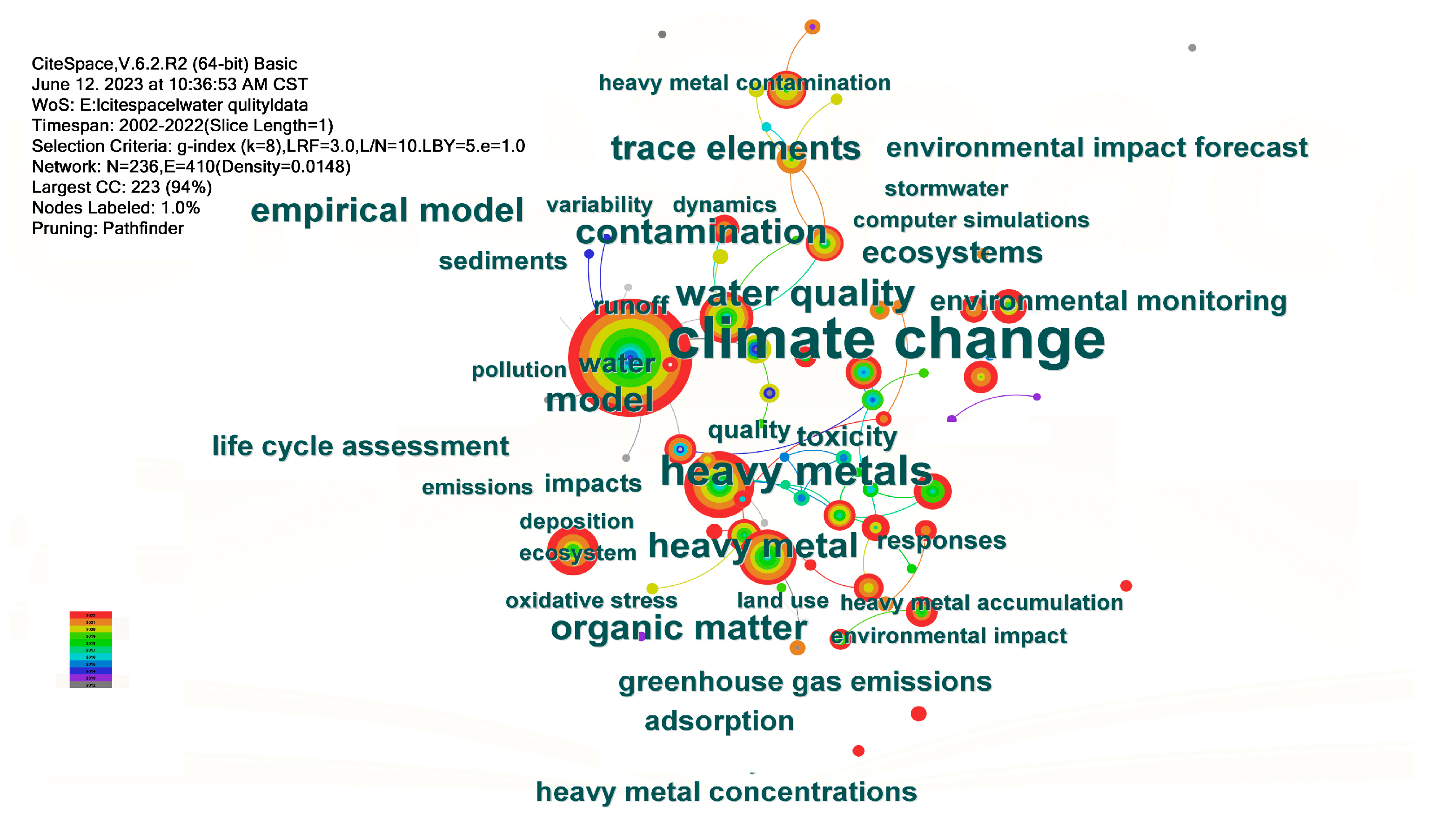Assessing the Performance and Challenges of Low-Impact Development under Climate Change: A Bibliometric Review
Abstract
:1. Introduction
2. Methodology
3. Results
3.1. Bibliometrics Analysis
3.1.1. Preeminent Sources and Contributors
3.1.2. Analysis of Research Topics via Keyword Co-Occurrence
3.2. Hydrological Impacts of LID in the Context of Climate Change
3.2.1. Evaluating Performance of LID in Enhancing Hydrology
3.2.2. LID Efficacy in Anticipated Climate Scenarios
3.3. Impact of LID on Water Quality under Climate Change
3.3.1. Evaluating Performance of LID in Enhancing Water Quality
3.3.2. Assessing the Resilience of LID in Future Scenarios
3.4. Strategic Optimization for LID Implementation
4. Discussion
4.1. Quantifying LID Effects on Water Quality
4.2. Advancing LID Modeling under Changing Climates
4.3. Integrating LID, Climate Change, and Water Policy
5. Conclusions
Author Contributions
Funding
Institutional Review Board Statement
Informed Consent Statement
Data Availability Statement
Conflicts of Interest
Abbreviations
References
- Williams, A.P.; Cook, B.I.; Smerdon, J.E. Rapid intensification of the emerging southwestern North American megadrought in 2020–2021. Nat. Clim. Chang. 2022, 12, 232–234. [Google Scholar] [CrossRef]
- Jouberton, A.; Shaw, T.E.; Miles, E.; McCarthy, M.; Fugger, S.; Ren, S.; Dehecq, A.; Yang, W.; Pellicciotti, F. Warming-induced monsoon precipitation phase change intensifies glacier mass loss in the southeastern Tibetan Plateau. Proc. Natl. Acad. Sci. USA 2022, 119, e2109796119. [Google Scholar] [CrossRef]
- Maina, F.Z.; Kumar, S.V. Diverging trends in rain-on-snow over high mountain Asia. Earth’s Future 2023, 11, e2022EF003009. [Google Scholar] [CrossRef]
- Tefera, G.W.; Ray, R.L. Hydrology and hydrological extremes under climate change scenarios in the Bosque watershed, North-Central Texas, USA. Environ. Sci. Pollut. Res. 2023, 1–19. [Google Scholar] [CrossRef] [PubMed]
- Miu, L.M. The impact of climate change on wind power production in Scotland. Energy Sustain. V Spec. Contrib. 2015, 206, 239. [Google Scholar]
- Garnello, A.; Marchenko, S.; Nicolsky, D.; Romanovsky, V.; Ledman, J.; Celis, G.; Schadel, C.; Luo, Y.; Schuur, E.A.G. Projecting Permafrost Thaw of Sub-Arctic Tundra with a Thermodynamic Model Calibrated to Site Measurements. J. Geophys. Res. Biogeosci. 2021, 126, e2020JG006218. [Google Scholar] [CrossRef]
- Qiao, Y.; Jiang, Y.; Zhang, C. Contribution of karst ecological restoration engineering to vegetation greening in southwest China during recent decade. Ecol. Indic. 2021, 121, 107081. [Google Scholar] [CrossRef]
- Wang, Z.; Wu, R.; Chen, Z.; Huang, G.; Yang, X. Reasons for East Siberia winter snow water equivalent increase in the recent decades. Remote Sens. 2022, 15, 134. [Google Scholar] [CrossRef]
- Valjarević, A.; Popovici, C.; Štilić, A.; Radojković, M. Cloudiness and water from cloud seeding in connection with plants distribution in the republic of Moldova. Appl. Water Sci. 2022, 12, 262. [Google Scholar] [CrossRef]
- Senes, G.; Ferrario, P.S.; Cirone, G.; Fumagalli, N.; Frattini, P.; Sacchi, G.; Valè, G. Nature-based solutions for storm water management—Creation of a green infrastructure suitability map as a tool for land-use planning at the municipal level in the province of monza-brianza (Italy). Sustainability 2021, 13, 6142. [Google Scholar] [CrossRef]
- Voskamp, I.M.; Van de Ven, F.H.M. Planning support system for climate adaptation: Composing effective sets of blue-green measures to reduce urban vulnerability to extreme weather events. Build. Environ. 2015, 83, 159–167. [Google Scholar] [CrossRef]
- Eckart, K.; McPhee, Z.; Bolisetti, T. Multiobjective optimization of low impact development stormwater controls. J. Hydrol. 2018, 562, 564–576. [Google Scholar] [CrossRef]
- Li, Q.; Wang, F.; Yu, Y.; Huang, Z.C.; Li, M.T.; Guan, Y.T. Comprehensive performance evaluation of LID practices for the sponge city construction: A case study in Guangxi, China. J. Environ. Manag. 2019, 231, 10–20. [Google Scholar] [CrossRef] [PubMed]
- Wang, M.; Jiang, Z.; Zhang, D.; Zhang, Y.; Liu, M.; Rao, Q.; Li, J.; Tan, S.K. Optimization of integrating life cycle cost and systematic resilience for grey-green stormwater infrastructure. Sustain. Cities Soc. 2023, 90, 104379. [Google Scholar] [CrossRef]
- Pour, S.H.; Wahab, A.K.A.; Shahid, S.; Asaduzzaman, M.; Dewan, A. Low impact development techniques to mitigate the impacts of climate-change-induced urban floods: Current trends, issues, and challenges. Sustain. Cities Soc. 2020, 62, 102373. [Google Scholar] [CrossRef]
- Ludwig, F.; van Slobbe, E.; Cofino, W. Climate change adaptation and Integrated water resource management in the water sector. J. Hydrol. 2014, 518, 235–242. [Google Scholar] [CrossRef]
- Coffman, L.S.; Goo, R.; Frederick, R. Low-impact development: An innovative alternative approach to stormwater management. In WRPMD’99: Preparing for the 21st Century; Asce Library: Reston, VA, USA, 1999; pp. 1–10. [Google Scholar]
- Radcliffe, J. Australia’s water sensitive urban design. In Proceedings of the 2018 International Sponge City Conference, Xi’an, China, 8–10 September 2018; pp. 38–52. [Google Scholar]
- Eason, C.; Gray, R.; Leighton, D.; Trowsdale, S.; Vale, R. Advancing low impact stormwater management within a sustainable urban development framework. In Proceedings of the New Zealand Water & Wastes Association Stormwater Conference, Rotorua, New Zealand, 8–10 May 2006. [Google Scholar]
- Whelans, C.; Maunsell, H.G.; Thompson, P. Planning and Management Guidelines for Water Sensitive Urban (Residential) Design; Department of Planning and Urban Development of Western Australia: Perth, WA, Australia, 1994. [Google Scholar]
- Butler, D.; Parkinson, J. Towards sustainable urban drainage. Water Sci. Technol. 1997, 35, 53–63. [Google Scholar] [CrossRef]
- Halil, I.B.; Yılmaz, I.; Yalçın, B.; Murat, K. Water quality tendency of Akarcay River between 2006–2011. Pamukkale Univ. J. Eng. Sci. 2013, 19, 127–132. [Google Scholar]
- Cao, Q.; Cao, J.; Xu, R. Optimizing low impact development for stormwater runoff treatment: A case study in Yixing, China. Water 2023, 15, 989. [Google Scholar] [CrossRef]
- Yan, C.; Ding, J.; Wang, B.; Qin, L.; Shi, Z.; Qiu, Q.Y. An in-situ measurement and assessment of evaporative cooling effects of low impact development facilities in a subtropical city. Agric. Forest Meteorol. 2023, 332, 109363. [Google Scholar] [CrossRef]
- Wang, M.; Zhang, D.; Cheng, Y.; Tan, S.K. Assessing performance of porous pavements and bioretention cells for stormwater management in response to probable climatic changes. J. Environ. Manag. 2019, 243, 157–167. [Google Scholar] [CrossRef] [PubMed]
- Lisenbee, W.A.; Hathaway, J.M.; Winston, R.J. Modeling bioretention hydrology: Quantifying the performance of DRAINMOD-urban and the SWMM LID module. J. Hydrol. 2022, 612, 128179. [Google Scholar] [CrossRef]
- Zhang, X.; Jia, H. Low impact development planning through a comprehensive optimization framework: Current gaps and future perspectives. Resour. Conserv. Recycl. 2023, 190, 106861. [Google Scholar] [CrossRef]
- Cronin, C. Doing your literature review: Traditional and systematic techniques. Eval. Res. Educ. 2011, 24, 219–221. [Google Scholar] [CrossRef]
- Fetscherin, M.; Usunier, J.C. Corporate branding: An interdisciplinary literature review. Eur. J. Mark. 2012, 46, 733–753. [Google Scholar] [CrossRef]
- Meerow, S.; Newell, J.P. Spatial planning for multifunctional green infrastructure: Growing resilience in Detroit. Landsc. Urban Planing 2017, 159, 62–75. [Google Scholar] [CrossRef]
- Liu, H.; Kong, F.; Yin, H.; Middel, A.; Zheng, X.; Huang, J.; Xu, H.; Ding, W.; Wen, Z. Impacts of green roofs on water, temperature, and air quality: A bibliometric review. Build. Environ. 2021, 196, 107794. [Google Scholar] [CrossRef]
- Mantilla, I.; Flanagan, K.; Muthanna, T.M.; Blecken, G.T.; Viklander, M. Variability of green infrastructure performance due to climatic regimes across Sweden. J. Environ. Manag. 2023, 326, 116354. [Google Scholar] [CrossRef]
- Hill, B.; Liang, Q.; Bosher, L.; Chen, H.; Nicholson, A. A systematic review of natural flood management modelling: Approaches, limitations, and potential solutions. J. Flood Risk Manag. 2023, 16, 12899. [Google Scholar] [CrossRef]
- Martin, W.D.; Kaye, N.B. Modeling of the hydrologic performance of distributed LID stormwater under a changing climate: Municipal-scale performance improvements. J. Sustain. Water Buil. 2023, 9, 04023005. [Google Scholar] [CrossRef]
- Xu, D.; Yin, X.Q.; Zhou, S.; Jiang, Y.J.; Xi, X.L.; Sun, H.M.; Wang, J. A review on the remediation of microplastics using constructed wetlands: Bibliometric, co-occurrence, current trends, and future directions. Chemosphere 2022, 303, 134990. [Google Scholar] [CrossRef]
- Xia, Q.; Yan, S.; Li, H.; Duan, K.; Zhang, Y. A bibliometric analysis of knowledge-hiding research. Behav. Sci. 2022, 12, 122. [Google Scholar] [CrossRef]
- Chen, C.; Ibekwe-SanJuan, F.; Hou, J. The structure and dynamics of cocitation clusters: A multiple perspective cocitation analysis. J. Am. Soc. Inf. Sci. Technol. 2010, 61, 1386–1409. [Google Scholar] [CrossRef]
- Chen, C. Science mapping: A systematic review of the literature. J. Data Inf. Sci. 2017, 2, 1–40. [Google Scholar] [CrossRef]
- Kabisch, N.; Frantzeskaki, N.; Pauleit, S.; Naumann, S.; Davis, M.; Artmann, M.; Haase, D.; Knapp, S.; Korn, H.; Stadler, J.; et al. Nature-based solutions to climate change mitigation and adaptation in urban areas: Perspectives on indicators, knowledge gaps, barriers, and opportunities for action. Ecol. Soc. 2016, 21, 39. [Google Scholar] [CrossRef]
- Kaykhosravi, S.; Khan, U.; Jadidi, A. A comprehensive review of low impact development models for research, conceptual, preliminary and detailed design applications. Water 2018, 10, 1514. [Google Scholar] [CrossRef]
- Alexander, K.; Hettiarachchi, S.; Ou, Y.; Sharma, A. Can integrated green spaces and storage facilities absorb the increased risk of flooding due to climate change in developed urban environments? J. Hydrol. 2019, 579, 124201. [Google Scholar] [CrossRef]
- Zahmatkesh, Z.; Karamouz, M.; Goharian, E.; Burian, S. Analysis of the effects of climate change on urban storm water runoff using statistically downscaled precipitation data and a change factor approach. J. Hydrol. Eng. 2015, 20, 05014022. [Google Scholar] [CrossRef]
- Neupane, B.; Vu, T.M.; Mishra, A.K. Evaluation of land-use, climate change, and low-impact development practices on urban flooding. Hydrol. Sci. J. 2021, 66, 1729–1742. [Google Scholar] [CrossRef]
- Dutta, A.; Torres, A.S.; Vojinovic, Z. Evaluation of pollutant removal efficiency by small-scale nature-based solutions focusing on bio-retention cells, vegetative swale and porous pavement. Water 2021, 13, 2361. [Google Scholar] [CrossRef]
- Kefi, M.; Mishra, B.; Kumar, P.; Masago, Y.; Fukushi, K. Assessment of tangible direct flood damage using a spatial analysis approach under the effects of climate change: Case study in an urban watershed in Hanoi, Vietnam. ISPRS Int. J. Geo Inf. 2018, 7, 29. [Google Scholar] [CrossRef]
- Sohn, W.; Kim, J.H.; Li, M.H.; Brown, R. The influence of climate on the effectiveness of low impact development: A systematic review. J. Environ. Manag. 2019, 236, 365–379. [Google Scholar] [CrossRef] [PubMed]
- Li, Y.; Babcock, R. Green roof hydrologic performance and modeling: A review. Water Sci. Technol. A J. Int. Assoc. Water Pollut. Res. 2014, 69, 727–738. [Google Scholar] [CrossRef] [PubMed]
- Qin, H.; Li, Z.X.; Fu, G. The effects of low impact development on urban flooding under different rainfall characteristics. J. Environ. Manag. 2013, 129, 577–585. [Google Scholar] [CrossRef] [PubMed]
- Ekmekcioglu, O.; Yilmaz, M.; Ozger, M.; Tosunoglu, F. Investigation of the low impact development strategies for highly urbanized area via auto-calibrated Storm Water Management Model (SWMM). Water Sci. Technol. 2021, 84, 2194–2213. [Google Scholar] [CrossRef]
- Lewellyn, C.; Lyons, C.; Traver, R.; Wadzuk, B. Evaluation of seasonal and large storm runoff volume capture of an infiltration green infrastructure system. J. Hydrol. Eng. 2015, 2, 04015047. [Google Scholar] [CrossRef]
- Palermo, S.A.; Talarico, V.C.; Turco, M. On the LID systems effectiveness for urban stormwater management: Case study in Italy. IOP Conf. Ser. Earth Environ. Sci. 2020, 410, 012012. [Google Scholar] [CrossRef]
- Sun, X.; Li, R.; Shan, X.; Xu, H.; Wang, J. Assessment of climate change impacts and urban flood management schemes in central Shanghai. Int. J. Disast. Risk Reduct. 2021, 65, 102563. [Google Scholar] [CrossRef]
- Gharbia, S.S.; Gill, L.; Johnston, P.; Pilla, F. Multi-GCM ensembles performance for climate projection on a GIS platform. Model. Earth Syst. Env. 2016, 2, 102. [Google Scholar] [CrossRef]
- Mattos, T.; Oliveira, P.T.; Bruno, L.; Oliveira, N.; Vasconcelos, J.; Lucas, M. Improving urban flood resilience under climate change scenarios in a tropical watershed using low-impact development practices. J. Hydrol. Eng. 2021, 26, 05021031. [Google Scholar] [CrossRef]
- Liu, W.; Feng, Q.; Engel, B.A.; Zhang, X. Cost-effectiveness analysis of extensive green roofs for urban stormwater control in response to future climate change scenarios. Sci. Total Environ. 2023, 856, 159127. [Google Scholar] [CrossRef] [PubMed]
- Wang, Z.; Zhou, S.; Wang, M.; Zhang, D. Cost-benefit analysis of low-impact development at hectare scale for urban stormwater source control in response to anticipated climatic change. J. Environ. Manag. 2020, 264, 110483. [Google Scholar] [CrossRef]
- Zahmatkesh, Z.; Burian, S.; Karamouz, M.; Tavakol-Davani, H.; Goharian, E. Low-impact development practices to mitigate climate change effects on urban stormwater runoff: Case study of New York city. J. Irrig. Drain. Eng. 2014, 141, 04014043. [Google Scholar] [CrossRef]
- Pennino, M.J.; McDonald, R.I.; Jaffe, P.R. Watershed-scale impacts of stormwater green infrastructure on hydrology, nutrient fluxes, and combined sewer overflows in the mid-Atlantic region. Sci. Total Environ. 2016, 565, 1044–1053. [Google Scholar] [CrossRef] [PubMed]
- Akhtar, M.; Ahmad, N.; Booij, M.J. The impact of climate change on the water resources of Hindukush–Karakorum–Himalaya region under different glacier coverage scenarios. J. Hydrol. 2008, 355, 148–163. [Google Scholar] [CrossRef]
- Fabian, P.S.; Kwon, H.H.; Vithanage, M.; Lee, J.H. Modeling, challenges, and strategies for understanding impacts of climate extremes (droughts and floods) on water quality in Asia: A review. Environ. Res. 2023, 225, 115617. [Google Scholar] [CrossRef]
- Schindler, D.W.; Carpenter, S.R.; Chapra, S.C.; Hecky, R.E.; Orihel, D.M. Reducing phosphorus to curb lake eutrophication is a success. Environ. Sci. Technol. 2016, 50, 8923–8929. [Google Scholar] [CrossRef]
- Khoi, D.N.; Phi, H.L. Impact of climate change on streamflow and water quality in the upper Dong Nai river basin, Vietnam. La Houille Blanche 2018, 104, 70–79. [Google Scholar] [CrossRef]
- Whitehead, P.G.; Jin, L.; Bussi, G.; Voepel, H.E.; Darby, S.E.; Vasilopoulos, G.; Manley, R.; Rodda, H.; Hutton, C.; Hackney, C.; et al. Water quality modelling of the Mekong River basin: Climate change and socioeconomics drive flow and nutrient flux changes to the Mekong Delta. Sci. Total Environ. 2019, 673, 218–229. [Google Scholar] [CrossRef]
- Karakouzian, M.; Taheriyoun, M.; Nazari-Sharabian, M. Surface runoff and pollutant load response to urbanization, climate variability, and low impact developments—A case study. Water Supply 2019, 19, 2410–2421. [Google Scholar]
- Liu, Y.; Bralts, V.F.; Engel, B.A. Evaluating the effectiveness of management practices on hydrology and water quality at watershed scale with a rainfall-runoff model. Sci. Total Environ. 2015, 511, 298–308. [Google Scholar] [CrossRef] [PubMed]
- Lam, Q.D.; Schmalz, B.; Fohrer, N. The impact of agricultural Best Management Practices on water quality in a North German lowland catchment. Environ. Monit. Assess. 2011, 183, 351–379. [Google Scholar] [CrossRef]
- Zhang, L.; Ye, Z.; Shibata, S. Assessment of rain garden effects for the management of urban storm runoff in Japan. Sustainability 2020, 12, 9982. [Google Scholar] [CrossRef]
- Taghizadeh, S.; Khani, S.; Rajaee, T. Hybrid SWMM and particle swarm optimization model for urban runoff water quality control by using green infrastructures (LID-BMPs). Urban For. Urban Green. 2021, 60, 127032. [Google Scholar] [CrossRef]
- Yang, W.; Zhang, J.; Krebs, P. Low impact development practices mitigate urban flooding and non-point pollution under climate change. J. Clean. Prod. 2022, 347, 131320. [Google Scholar] [CrossRef]
- Sharma, A.K.; Vezzaro, L.; Birch, H.; Arnbjerg-Nielsen, K.; Mikkelsen, P.S. Effect of climate change on stormwater runoff characteristics and treatment efficiencies of stormwater retention ponds: A case study from Denmark using TSS and Cu as indicator pollutants. Springerplus 2016, 5, 1984. [Google Scholar] [CrossRef]
- Baek, S.S.; Ligaraya, M.; Pyoa, J.; Parkb, J.; Kangc, J.; Pachepskyd, Y.; Chune, J.A.; Cho, K.H. A novel water quality module of the SWMM model for assessing low impact development (LID) in urban watersheds. J. Hydrol. 2020, 586, 124886. [Google Scholar] [CrossRef]
- Zhang, K.; Manuelpillai, D.; Raut, B.; Deletic, A.; Bach, P.M. Evaluating the reliability of stormwater treatment systems under various future climate conditions. J. Hydrol. 2019, 568, 57–66. [Google Scholar] [CrossRef]
- Burge, K.; Breen, D.; Breen, P.; Wingad, J. Water sensitive urban design in a changing climate estimating the performance of WSUD treatment measures under various climate change scenarios. WSUD 2012: Water Sensitive Urban Design; Building the Water Sensitive Community. In Proceedings of the 7th International Conference on Water Sensitive Urban Design, Melbourne, VIC, Australia, 21–23 March 2012; pp. 119–126. [Google Scholar]
- Tansar, H.; Duan, H.-F.; Mark, O. Catchment-scale and local-scale based evaluation of LID effectiveness on urban drainage system performance. Water Resour. Manag. 2022, 36, 507–526. [Google Scholar] [CrossRef]
- Lopes, M.; Silva, G. An efficient simulation-optimization approach based on genetic algorithms and hydrologic modeling to assist in identifying optimal low impact development designs. Landsc. Urban Plan. 2021, 216, 104251. [Google Scholar] [CrossRef]
- Leng, L.; Jia, H.; Chen, S.A.; Zhu, D.Z.; Xu, T.; Yu, S. Multi-objective optimization for green-grey infrastructures in response to external uncertainties. Sci. Total Environ. 2021, 775, 145831. [Google Scholar] [CrossRef]
- Ahiablame, L.M.; Engel, B.A.; Chaubey, I. Effectiveness of low impact development practices: Literature review and suggestions for future research. Water Air Soil Pollut. 2012, 223, 4253–4273. [Google Scholar] [CrossRef]
- Pyke, C.; Warren, M.P.; Johnson, T.; LaGro, J., Jr.; Scharfenberg, J.; Groth, P.; Groth, P.; Schroeder, W.; Main, E. Assessment of low impact development for managing stormwater with changing precipitation due to climate change. Landsc. Urban Plan. 2011, 103, 166–173. [Google Scholar] [CrossRef]
- Rosenberg, E.A.; Keys, P.W.; Booth, D.B.; Hartley, D.; Burkey, J.; Steinemann, A.C.; Lettenmaier, D.P. Precipitation extremes and the impacts of climate change on stormwater infrastructure in Washington State. Clim. Chang. 2010, 102, 319–349. [Google Scholar] [CrossRef]
- Hayes, A.T.; Jandaghian, Z.; Lacasse, M.A.; Gaur, A.; Lu, H.; Laouadi, A.; Ge, H.; Wang, L. Nature-based solutions (nbss) to mitigate urban heat island (UHI) effects in Canadian cities. Building 2022, 12, 925. [Google Scholar] [CrossRef]
- Wang, M.; Liu, M.; Zhang, D.; Qi, J.; Fu, W.; Zhang, Y.; Rao, Q.; Bakhshipour, A.E.; Tan, S.K. Assessing and optimizing the hydrological performance of Grey-Green infrastructure systems in response to climate change and non-stationary time series. Water Res. 2023, 232, 119720. [Google Scholar] [CrossRef]
- Parker, J.; de Baro, M.E.Z. Green infrastructure in the urban environment: A systematic quantitative review. Sustainability 2019, 11, 3182. [Google Scholar] [CrossRef]
- Membele, G.M.; Naidu, M.; Mutanga, O. Examining flood vulnerability mapping approaches in developing countries: A scoping review. Int. J. Disaster Risk Reduct. 2022, 69, 102766. [Google Scholar] [CrossRef]






| Country | Articles | Multiple Country Publications | Same Country Publications | Frequent | Same Country Publications/Multiple Country Publications |
|---|---|---|---|---|---|
| China | 210 | 130 | 80 | 0.157 | 0.615 |
| USA | 199 | 152 | 47 | 0.149 | 0.309 |
| United Kingdom | 127 | 61 | 66 | 0.095 | 1.082 |
| Australia | 81 | 42 | 39 | 0.061 | 0.929 |
| Italy | 75 | 45 | 30 | 0.056 | 0.667 |
| Germany | 58 | 39 | 19 | 0.043 | 0.487 |
| Spain | 58 | 35 | 23 | 0.043 | 0.657 |
| Canada | 53 | 34 | 19 | 0.040 | 0.559 |
| Netherlands | 41 | 17 | 24 | 0.031 | 1.412 |
| Sweden | 36 | 16 | 20 | 0.027 | 1.250 |
| Web of Science Categories | Record Count | Ratio |
|---|---|---|
| Environmental Sciences | 949 | 51.4% |
| Environmental Studies | 547 | 29.6% |
| Water Resources | 348 | 18.9% |
| Green Sustainable Science Technology | 337 | 18.2% |
| Urban Studies | 218 | 11.8% |
| Author | Articles | Articles Fractionalized | Local Citations |
|---|---|---|---|
| Pauleit, S. | 16 | 3.05 | 234 |
| Liu, Y.Z. | 13 | 2.17 | 114 |
| Vojinovic, Z. | 13 | 1.96 | 103 |
| Engel, B.A. | 12 | 2.00 | 123 |
| Kumar, P. | 12 | 2.02 | 73 |
| Keywords | Degree | Centrality | Keyword Frequency |
|---|---|---|---|
| Climate change | 33 | 0.17 | 700 |
| Green infrastructure | 23 | 0.10 | 430 |
| Nature-based solutions | 3 | 0.07 | 243 |
| Ecosystem service | 4 | 0.01 | 222 |
| Impact | 28 | 0.19 | 205 |
| City | 5 | 0.01 | 195 |
| Low-impact development | 26 | 0.28 | 177 |
| Ecosystem services | 2 | 0.01 | 160 |
| Model | 13 | 0.28 | 126 |
| Framework | 3 | 0.02 | 112 |
| Stormwater management | 3 | 0.03 | 110 |
Disclaimer/Publisher’s Note: The statements, opinions and data contained in all publications are solely those of the individual author(s) and contributor(s) and not of MDPI and/or the editor(s). MDPI and/or the editor(s) disclaim responsibility for any injury to people or property resulting from any ideas, methods, instructions or products referred to in the content. |
© 2023 by the authors. Licensee MDPI, Basel, Switzerland. This article is an open access article distributed under the terms and conditions of the Creative Commons Attribution (CC BY) license (https://creativecommons.org/licenses/by/4.0/).
Share and Cite
Wang, M.; Feng, S.; Ikram, R.M.A.; Chen, T.; Sun, C.; Chen, B.; Rao, Q.; Jin, H.; Li, J. Assessing the Performance and Challenges of Low-Impact Development under Climate Change: A Bibliometric Review. Sustainability 2023, 15, 13616. https://doi.org/10.3390/su151813616
Wang M, Feng S, Ikram RMA, Chen T, Sun C, Chen B, Rao Q, Jin H, Li J. Assessing the Performance and Challenges of Low-Impact Development under Climate Change: A Bibliometric Review. Sustainability. 2023; 15(18):13616. https://doi.org/10.3390/su151813616
Chicago/Turabian StyleWang, Mo, Sijie Feng, Rana Muhammad Adnan Ikram, Tong Chen, Chuanhao Sun, Biyi Chen, Qiuyi Rao, He Jin, and Jianjun Li. 2023. "Assessing the Performance and Challenges of Low-Impact Development under Climate Change: A Bibliometric Review" Sustainability 15, no. 18: 13616. https://doi.org/10.3390/su151813616
APA StyleWang, M., Feng, S., Ikram, R. M. A., Chen, T., Sun, C., Chen, B., Rao, Q., Jin, H., & Li, J. (2023). Assessing the Performance and Challenges of Low-Impact Development under Climate Change: A Bibliometric Review. Sustainability, 15(18), 13616. https://doi.org/10.3390/su151813616









